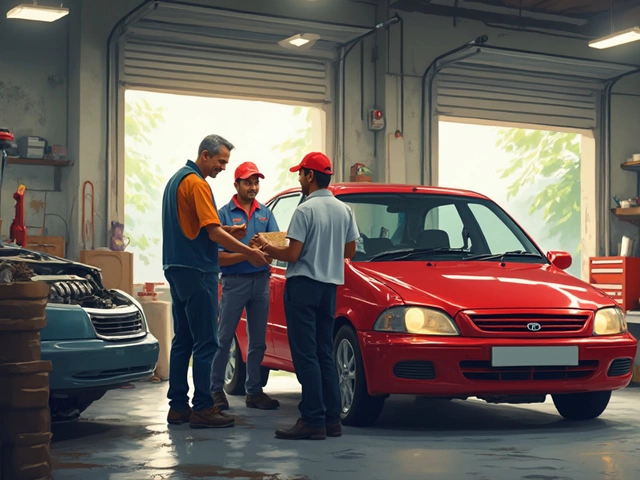Your car feels floaty over every bump, or maybe it bounces like a trampoline after every dip. Ever wonder if that’s your shocks or springs giving up? The answer matters, because bad suspension parts will turn even a short drive into a headache—and they’re sneaky about it. Catch the signs early, and you’ll save your tires, your wallet, and maybe your safety.
The first clue is usually in how your car handles. Excessive bouncing or rocking after hitting a bump? Shocks are likely toast. If your car is sagging on one corner or feels lower overall, a spring could be broken or worn out. Listen for weird clunks, squeaks, or metal-on-metal noises. These sounds are red flags your suspension’s at its limit.
Sticking your head under the car, you might spot oil leaking out of a shock or strut. That’s a dead giveaway—shocks are filled with fluid, and leaks mean they’re not working right. Rusty or cracked springs mean they can’t support your car’s weight anymore. Grab a flashlight, take a close look, and compare all four corners. Spotting problems early keeps you ahead of expensive repairs.
- Quick Symptoms: What Goes Wrong When Shocks or Springs Are Bad
- Check It Yourself: Hands-On Suspension Testing
- On the Road: How Different Problems Feel While Driving
- Fix or Replace? What to Do After You Spot an Issue
Quick Symptoms: What Goes Wrong When Shocks or Springs Are Bad
When your suspension starts acting up, you’ll usually spot the signs before things go off the rails. The trick is knowing what to watch for. Both shocks and springs protect your car from feeling every pothole, but when one’s bad, your whole ride changes.
Here’s what happens when shocks are shot:
- Excessive bouncing after a speed bump or dip. Push down on your hood or trunk—if it keeps bouncing instead of settling, those shocks are done.
- The car nose-dives when you brake or leans hard in a turn. This makes things unpredictable, especially in the rain or when you need to stop fast.
- Uneven wear patterns on your tires. Bad shocks let your wheels bounce around, making the tire tread look patchy or worn on the edges.
- Leaking fluid around the shock or strut. If you see oily spots where the shock connects, it’s finished.
Now, if a spring is bad, you’ll see different signs:
- One corner of the car sits lower than the others, or the whole car looks like it’s sagging down. Springs are literally holding up your car—if one’s gone, it can’t do its job.
- Clunking, popping, or rattling noises from underneath, especially going over bumps. A broken spring can rattle around or knock against other parts.
- A rougher, harsher ride. While shocks absorb motion, springs provide the cushion. Lose a spring and the ride stiffens up real quick.
- Visible cracks, rust, or pieces missing on the coil if you peek underneath. No guesswork here—a broken spring is pretty obvious when you look.
Ignoring any of these symptoms can end up costing you more than just new suspension parts. Bad shocks or springs mess with your steering, braking, and make your drive way less safe. Spotting these symptoms now means you can get ahead of a bad situation before it blows up your car budget—or worse, ruins your day.
Check It Yourself: Hands-On Suspension Testing
Don’t want to guess if your shocks or springs are bad? Good. Here’s how you get your hands dirty and know for sure, all without any fancy tools or expensive gear.
Start with the classic bounce test. Park on level ground, shut the engine off, and go to each corner of your car. Push down hard on the bumper or fender: really throw your weight into it. Let go, and watch what happens:
- If the car bounces up, down, or rocks more than 1-2 times, shocks aren’t damping motion anymore. A single bounce and quick stop? That’s what you want.
- If that corner feels softer or sinks lower than the others, the spring might be tired or broken.
Now, do a quick visual. Turn the wheels and look behind them if you have to. Check for any leaking oil around the shock or strut—if you spot a slick, shiny stain, that shock’s blown. Springs should look tight, unbroken, and have even gaps between each coil. A broken coil looks like a gap or even a piece missing entirely.
Got a tape measure? Measure wheel arch height from the ground, front and rear, both sides. Big differences (more than an inch) between sides? That’s a big clue the spring is weak or snapped. Check this chart for quick reference on what’s normal for common car types:
| Car Type | Expected Fender Ground Clearance (inches) | Warning Difference (inches) |
|---|---|---|
| Compact sedan | 26-28 | > 1 |
| SUV | 29-31 | > 1 |
| Pickup truck | 31-33 | > 1.5 |
Finally, listen up. Turn the steering wheel lock to lock while stopped. Hear any spring-like popping or grinding? That’s not normal. Springs or their mounts could be shot. All these little checks can give you a pretty accurate DIY diagnosis, so you’re not flying blind the next time your car starts handling weird.

On the Road: How Different Problems Feel While Driving
You can actually feel the difference when driving with bad shocks or springs, even if you’re not a car expert. Each problem shows up in its own way. Getting a handle on these differences is the fastest way to figure out what’s going wrong.
- Shocks gone bad make your car bounce more than it should after bumps or potholes. Normally, your car settles almost instantly. With worn shocks, that bouncing sticks around. If you go over a speed bump and your car bounces more than twice, your shocks are shot.
- Bad springs usually mean the ride feels uneven. You might feel the car bottoming out, especially if a spring is broken. One side might sag lower than the other. The steering wheel can jerk or feel odd, since the car’s weight isn’t balanced.
- If turns suddenly feel sloppy or the car sways a lot around corners, that’s a red flag for both parts but is usually worse with worn shocks. In wet weather, poor shocks will make your tires lose grip faster—testing shows braking distances can go up 12% if your shocks are really worn.
Here’s a quick comparison of what’s likely causing common suspension symptoms during real driving:
| Driving Symptom | Likely Cause |
|---|---|
| Bounces repeatedly after bumps | Bad shocks |
| Sagging corner or uneven ride height | Broken or worn spring |
| Car bottoms out on dips or heavy braking | Broken spring (can also be shocks) |
| Swerves or nose-dives when braking | Bad shocks |
| Loud clunking over bumps | Broken spring or loose shock |
Listen to how your car reacts when you drive over changes in the road. Does the front end keep bouncing? Are you sitting lower than usual? If yes, that’s your suspension telling you it’s time for a closer look. One more tip: If you have a family member ride along, have them listen and feel too—it’s easy to get used to a bad ride if you drive the car every day.
Fix or Replace? What to Do After You Spot an Issue
So you’ve found a leaky shock or a saggy spring—what now? You can't ignore these problems, because busted suspension parts only get worse. Here’s what you should do next to keep your ride safe and smooth.
First, decide if the bad part needs a quick fix or a full replacement. Most of the time, when shocks or springs go bad, there’s not much you can do except swap them out. Trying to patch up a leaking shock rarely works—it’s a sealed unit, so if oil's dripping out, it's done for. A cracked or broken spring is just as dangerous. Don’t try to weld or tape it up. The metal’s fatigued, and it can snap completely if you hit a big bump.
- If only one shock or spring is bad, best practice is to replace both (on the same axle) at the same time. Mixing old and new parts messes with your car's balance.
- Make sure to get the right size and type for your vehicle. Suspension parts aren’t all the same—check your car's manual or parts database.
- If you’re handy, replacing shocks or springs is doable with some basic tools, a jack, and jack stands. But if you’re not confident, go to a shop. Messing up suspension repairs can make your car unsafe.
Here’s what shops usually charge for these jobs on average in the U.S.:
| Part | DIY Cost (per pair) | Shop Cost (per pair) |
|---|---|---|
| Shocks | $100–$300 | $350–$900 |
| Springs | $80–$250 | $275–$650 |
For extra peace of mind, get an alignment check after replacing any suspension parts, especially if you replaced a spring. Out-of-whack alignment can chew through your tires faster than you’d think.
If you spot a problem with your shocks or springs, don’t put it off. Suspension keeps your car controllable and helps your brakes work right. Skipping repairs leads to unpredictable handling, tire wear, and sometimes even bigger damage.




